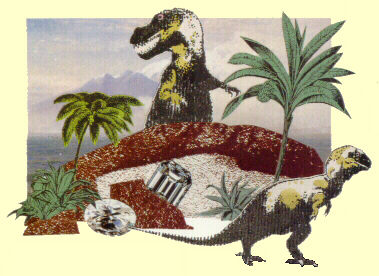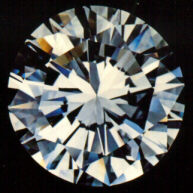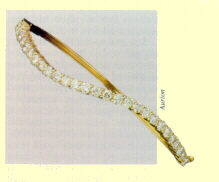
 |
TAKE A PIECE OF HISTORY IN YOUR HAND.
 Each diamond is unique. Like
fingerprints, no two are exactly
alike.
Diamonds have decorated
kings, inspired poets, delighted
movie stars, brought untimely
death to the famous and infamous- even been credited with
curing illnesses. British monarchs
added them to their royal treasure troves. French kings adored
them. Jehan Shah, builder of the Taj Mahal, wore an 88-carat heirloom at his coronation in 1628.
Each diamond is unique. Like
fingerprints, no two are exactly
alike.
Diamonds have decorated
kings, inspired poets, delighted
movie stars, brought untimely
death to the famous and infamous- even been credited with
curing illnesses. British monarchs
added them to their royal treasure troves. French kings adored
them. Jehan Shah, builder of the Taj Mahal, wore an 88-carat heirloom at his coronation in 1628.
The compulsion to own the very best survives in today's world of dwindling monarchies. Diamond auction fever is sweeping the world. In recent years, nine diamonds sold at either Christie's or Sotheby's New York auction house brought prices of between $185,200 and $926,315 a carat.
Consider, too, that American shoppers spent over $12 billion on diamond jewelry last year 30% more than they spent on all beauty aids and more than six times what they spent on furs. They said "I love you" with engagement rings. They said "I love you more than ever" with anniversary  bands. They celebrated birthdays and Christmas and special private moments with tennis bracelets and cocktail rings and
necklaces and pendants, all of them ablaze with diamonds. The top social set-and a few beauty
queens-drew all eyes with their shimmering new tiaras. Diamonds are the ultimate
symbol of romance. More than 500 years ago, in 1477, Maximillian of Austria gave a diamond ring to Mary of Burgundy to seal their marriage vows. Maximillian had obviously paid heed
to what the ancients said, namely that the third finger of the left hand connected directly to the heart by the Vein of Love. That's the finger he chose for Mary's ring.
bands. They celebrated birthdays and Christmas and special private moments with tennis bracelets and cocktail rings and
necklaces and pendants, all of them ablaze with diamonds. The top social set-and a few beauty
queens-drew all eyes with their shimmering new tiaras. Diamonds are the ultimate
symbol of romance. More than 500 years ago, in 1477, Maximillian of Austria gave a diamond ring to Mary of Burgundy to seal their marriage vows. Maximillian had obviously paid heed
to what the ancients said, namely that the third finger of the left hand connected directly to the heart by the Vein of Love. That's the finger he chose for Mary's ring.
Diamonds, too, offer an awesome connection with a Darwinian pre-history and lands populated with dinosaurs, not people. The youngest volcanic rock in which diamonds were brought to the earth's surface is about 70 million years old. When you pick up your diamond jewelry ring, cuff link or tiara -you are literally holding a piece of geological history in your hand. The diamond world is truly global. Today, the two richest sources of gem quality diamonds are Botswana, an emerging Third World country which relies on these gemstone for three-quarters of its total revenues, and the Soviet Union, whose bountiful mines are clustered in the frozen Siberian tundra.
For some curious reason, the most productive mines seem almost always to be found in inaccessible regions. The world's top producer, which only went into full operation in 1987, is the Argyle mine in the remote northern section of Western Australia. Last year, it produced more than 35 million carats, though most of them were of industrial quality.
The great trading and cutting centers are just as international: New York, Antwerp, Tel Aviv, Bombay are the primary cutting locations. They may soon have new rivals as twin moves to cut costs and build employment encourage new cutting facilities in Bangkok and even in China, which  is just beginning to dabble in the art. London remains the focal trading stop.
is just beginning to dabble in the art. London remains the focal trading stop.
Diamonds are hard beyond belief. It was ever so, as Pliny the Elder (23 to 79 A.D.) recorded long ago. The Greeks called diamond "adamas" or unconquerable. Pliny wrote that "the best way to test adamas is upon the anvil; strike even upon the point of the adamas with a hammer as hard as you can, it defies all blows and instead of the stone yielding, the hammer flies into pieces and even the anvil splits in half." No one knows if Pliny was talking practice or theory but 1,900 plus years later one thing is sure: don't even think about trying this experiment today, experts insist. Flawless, colorless diamonds the most perfect, desirable and, therefore, most costly - are the rarest of the rare. Of the 100 million or so carats mined each year, those in the very top grade number in the hundreds. What's more, about half of a rough diamond's total weight is lost in the cutting and polishing.
Diamonds personify value. The luxury car, the private plane, the regal fur all are passing pleasures. Diamonds are life-long reminders of love and attachment -and having sealed a bond for one generation they can be passed unblemished to the next. Diamonds are forever.